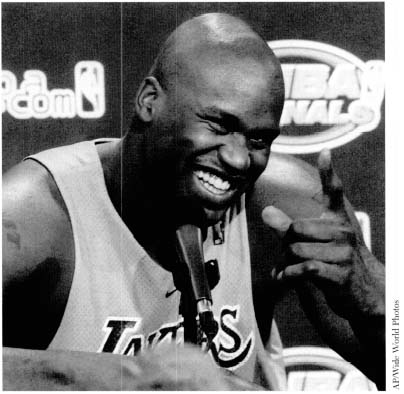On the Court With... Shaquille O'Neal (5 page)
Read On the Court With... Shaquille O'Neal Online
Authors: Matt Christopher
Tags: #Juvenile Nonfiction, #Basketball, #Sports & Recreation, #United States, #Biography & Autobiography, #African American, #People & Places

In one memorable play Shaquille got the ball
down low and the Arizona defense was slow to react. He faked one way, then spun quickly, lifted the ball with both hands,
and powered toward the basket.
For a moment, Shaquille seemed suspended in the air, a giant who had suddenly grown even larger.
He thundered the ball ferociously through the basket. As Arizona forward Sean Rooks cowered beneath him, Shaq hung on the
rim so he wouldn't land on his opponent's back. The image accurately reflected what was becoming obvious to everyone who saw
him play. Shaquille was head and shoulders above every other big man in college basketball.
For the next week it seemed as if every televised sports program in the country found an excuse to show a replay of Shaquille's
monstrous dunk. No one dunked the way he did, and fans loved seeing him do it. LSU defeated Arizona, 92–82. Shaquille racked
up 29 points, with 14 rebounds and 6 blocked shots.
The game sparked the best streak of Shaquille's short collegiate career. In his next game he scored a career-high 53 points
against Arkansas State. He followed that achievement with similarly dominant performances against some of the best teams in
the country.
But Shaquille was also demonstrating that he wasn't just a one-dimensional player. He hadn't just become stronger, he was
quicker and more agile, too.
Fans attending a game against Mississippi witnessed just how quick and agile he was. With the shot clock winding down, Shaquille
received the ball at the top of the key and tossed up a rare long-range jumper. The shot missed but the ricochet bounced straight
back toward him.
When Shaquille had been younger, his favorite player in the NBA had been Philadelphia 76er forward Julius Erving. Erving,
a lithe six feet eight inches, was a silky-smooth leaper known for his ability to launch himself into the air far away from
the basket and still be able to reach out and dunk the ball.
Although Shaquille didn't have the ball, his next move reminded fans of Erving. From the foul line he took one great leap.
Up he went toward the basket, his head almost even with the rim. He caught the ball in midair about three feet short of the
basket, then thundered it through the hoop with both hands as he came down.
For a moment the gymnasium was almost silent,
as if no one could believe that a player of Shaquille's size could leap so high and so far. Then the gym erupted with a huge
roar.
No one from any team seemed capable of stopping him. As he became more confident, he delivered more surprises, such as looking
one way but passing another and hitting teammates with behind-the-back passes like a point guard.
There hadn't been a collegiate center as good as Shaquille in years. Basketball observers were saying that Shaquille could
step into the NBA and instantly be one of the best centers in the league. In fact, there seemed to be only one thing he couldn't
do on the basketball court — shoot free throws.
Shaquille has a hard time making free throws in games. It isn't because of a lack of practice, as he has spent hours shooting
thousands of free throws and working on his technique. But few people realize that it is physically a difficult shot for him.
When he was a kid, he fell out of a tree and broke his right wrist. After the break healed, the wrist didn't bend as much
as it should. Today he is unable to shoot the ball in a high arc. Instead, all he can do is sort of “shot-put” the ball in
a straight line. He also seems
to freeze up a little in games, because in practice he generally makes about 70 percent of his free throws. But in games he
struggles to hit 50 percent.
The opposition took note. Late in close games, they would often foul Shaquille on purpose rather than try to stop him from
shooting cleanly. If he missed his free throws, the opposition would get the ball back. If they then made their shots, they
could make up a deficit quickly or expand a small lead. As one coach said, “You had to foul him; otherwise, he would win a
game by himself.” As a result, LSU would sometimes lose close games that they could have won.
Still, Shaquille was becoming one of the most popular players in the entire country. Fans sometimes booed their own team when
they started fouling him. They wanted to see him dunk the ball, not shoot free throws, even if their own team lost.
For despite his immense size, there was something about Shaquille off the court that drew fans to him, particularly young
kids. He had a quick smile and seemed to enjoy himself. In interviews, he could be funny and gave his dunks names like the
“Love Shaq” and “Unreal O'Neal.” Youngsters looked up to him as if he were some real-life superhero,
and Shaquille knew how to goof around with kids and make them smile. After all, when he was younger he had often baby-sat
for his own brothers and sisters. He was only eighteen years old and in some ways was still just a big kid himself.
LSU began to creep up in the national rankings, and for a while some people thought the team had a chance to reach the NCAA
finals, but late in the season Shaquille was sidelined by a hairline fracture in his leg. At the same time, the Tigers lost
another key player to injury.
Forced to play without Shaquille, the Tigers just couldn't keep up, losing their regular-season finale and their first game
in the SEC tournament. Although Shaquille returned for the opening game of the NCAA tournament and played well, LSU lost.
It was a disappointing end to a remarkable season. Most basketball organizations named him the collegiate Player of the Year.
Although it was clear that Shaquille would be the first pick in the NBA draft if he chose to quit school and turn professional,
he wanted to win an NCAA title and was determined to get his degree. He told everyone that he intended to stay in school until
he graduated and accomplished both goals.
But in Shaquille's junior year at LSU, things changed. It didn't seem possible, but Shaquille was even bigger and stronger.
The opposition was even more helpless to stop him.
Unfortunately, the rest of the Tigers didn't give him much help. Opposing teams realized that if they could manage to slow
down Shaquille, no one else on his team was able to beat them. So most teams concentrated on shutting the door in Shaquille's
face.
Shaquille began to get frustrated. Almost every time he got the ball, he was fouled and hacked. Teams even used players who
rarely played otherwise, just so they could foul him. In some games he was fouled almost every time he got the ball. Coach
Brown, his teammates, and even Shaquille's father began to complain about the way he was being treated. “He's taking a terrific
beating,” said Brown after one particularly rough game. They were all afraid that Shaquille would get hurt.
To protect himself, Shaquille took out an insurance policy worth $2 million if he were injured and couldn't play basketball
anymore. But that was only a fraction of what he would be able to earn as a professional.
As the season wore on, it didn't seem as if it was worth the risk for him to keep playing.
The situation came to a head in the SEC tournament. Shaquille finally grew tired of being fouled, and after one particularly
rough play, he struck back and got into a fight with another player. A huge brawl broke out as Shaquille's teammates came
to his defense. But in the end, Shaquille was thrown out of the game. When LSU lost in the second round of the NCAA tournament
to end their season, Shaquille knew it was time to make a decision.
He and his parents spent several nights talking about whether he should complete his senior year in college or turn professional.
Although Shaquille promised that he would get his degree even if he turned pro, Shaquille's father had made the same promise
to himself when he had dropped out of college. But he'd never found the time to return and now regretted the decision. “I
want him [Shaquille] to have that diploma so he'll have something real to depend on.”
That was a strong argument, but so was the argument that by staying in college another year, Shaquille was risking getting
injured. After talking it over with
his parents and Coach Brown, Shaquille decided to turn pro. He called a press conference on April 3, 1991, and announced his
decision.
“I feel in my heart it's time for a change and time to move on,” he said. “I said to myself, 'Are you having fun?' And I reviewed
in my mind this past season. I wasn't having that much fun. I was told at an early age, if it's not fun, do something else.”
“Something else” would be playing professional basketball. Shaquille O'Neal was ready to have some fun.
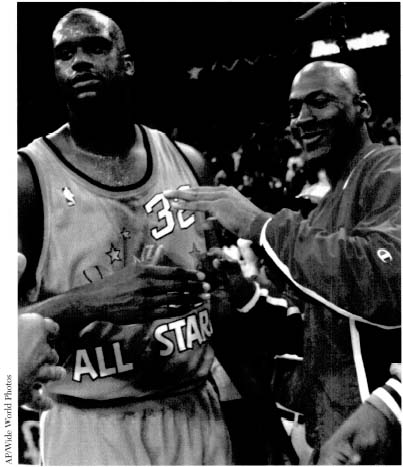
All-Stars Shaquille O'Neal and Micheal Jordan joke around after the 1996 game. Shaq outshot Jordan 25–20, but Jordan took
home the MVP award.
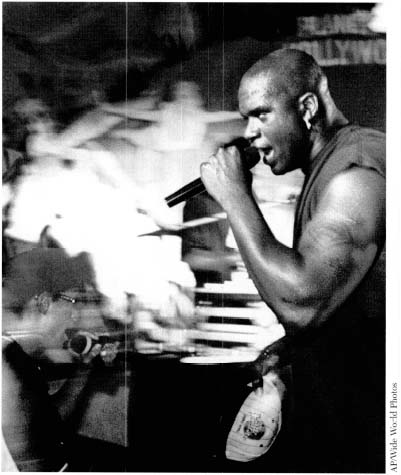
Multitalented O'Neal raps during a 1997 concert in Hong Kong.
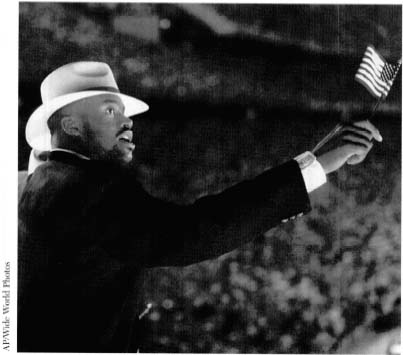
O' Neal waves his American flag during the opening ceremony of the 1996 Olympic Games in Atlanta.
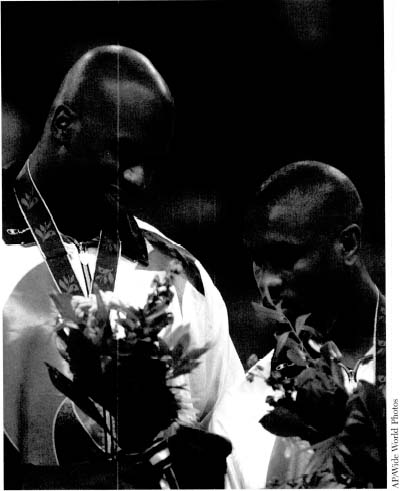
Shaq and the other Dream Team members (including Gary Payton, here) took home Olympic gold in 1996.
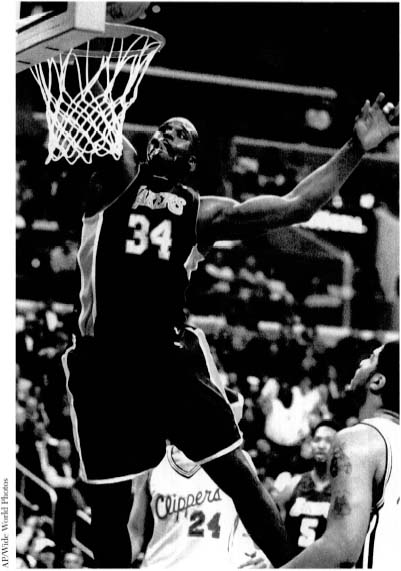
Shaq slams home a dunk during a game in 2000; he scored a career-high 61 points that night.
